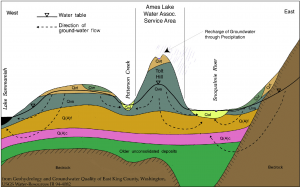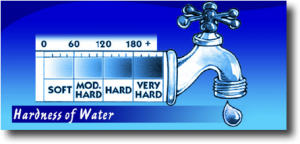Our Water Resource
Members of the Ames Lake Water Association drink and use groundwater for our household needs. Each year, the Association produces about 65 to 80 million gallons of groundwater that are pumped from 6 production wells spread throughout the Association’s 10 square mile Service Area to six storage tanks that collectively hold over one million gallons of water. This water is then delivered via water mains and service lines to your home for your use any time of the day.
Where does our Water come from?
The groundwater that you use for drinking and other domestic purposes comes from aquifers that were deposited during the last major glaciation event (Vashon Stade) that occurred approximately 13 – 16 thousand years ago. These vast glaciers, streams and lakes deposited inter-layered coarser material (sand and gravel) glacial sediments that now act as aquifers and also deposited finer grained sediment layers (silts and clays) act as aquitards protecting the underlying aquifers.
These aquifers are recharged by precipitation (rain and snow) that falls in the local area (Ames Lake / Tolt Hill Area and Eastern portion of Sammamish Plateau). This precipitation slowly passes through the various sediments until it reaches the aquifer and is eventually withdrawn many decades later or longer by the Association’s production wells. We anticipate having sufficient recharge in our relatively sparsely populated area to meet future water demands by ALWA Members. In addition, the Association’s groundwater supply is fairly tolerant to periodic droughts and we have not been adversely affected by droughts to date. However, as this precipitation flows across the surface and begins it’s decent to the aquifers it may pickup chemicals, solvents or other materials that have been improperly disposed by Homeowners.
This is why it is very important to “Practice Good Housekeeping” and properly dispose of any chemical, fuels, oils and solvents. Please do not dump these materials on the ground. In addition, old abandoned wells can act as a conduit to more rapidly move potential contaminants to the aquifers. If you have any old wells, please consider properly sealing and abandoning the unused well. If you have a well that you use for irrigation or other purposes, please do not store any chemicals, oils or solvents in the well house or in close proximity to the wellhead.
What is in our Water?
Each year, the Ames Lake Water Association distributes a Consumer Confidence Report that provides additional information on the water produced by the Association and reports on the routine sampling and testing performed by the Association. We work diligently so that you may enjoy very good quality groundwater. Our water is at the low end of the Moderately Hard (70 – 74 mg/L) scale of water hardness. The Water Hardness Scale runs from Soft – Moderately Hard – Hard – Vey Hard. Our groundwater is in the “sweet spot” of water hardness (low Moderately Hard) avoiding the problems of too soft and too hard groundwater. Many of us have visited or lived in other parts of the United States with differing quality and hardness levels of water and can truly appreciate the quality water we have at Ames lake Water Association. We do not add any disinfectant or fluoride to your drinking water. For families with growing children, you may want to consult your family dentist to determine if any fluoride rinses or toothpaste might be suggested.




